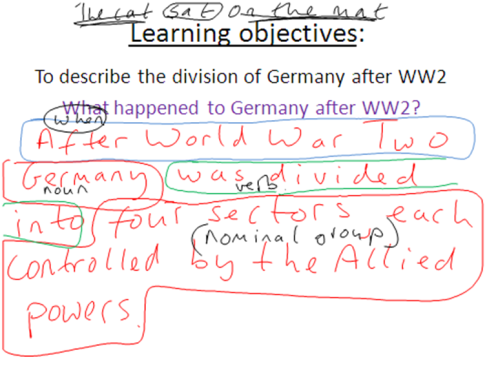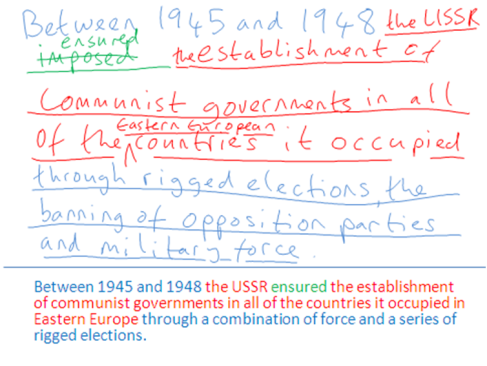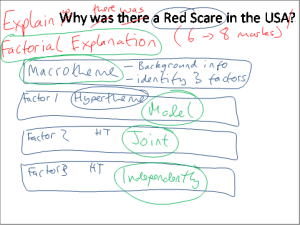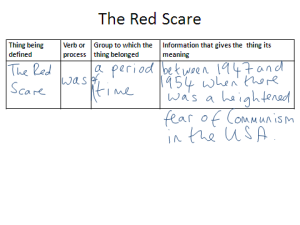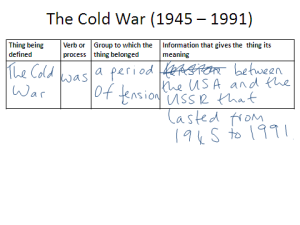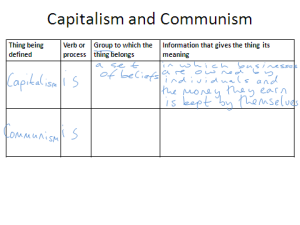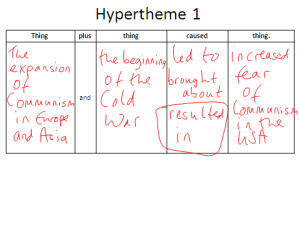I hit a bit of a wall this week. But then I started to wrestle with something I had put off wrestling with for a while and think I managed, to quote Jim Morrison, to break on through to the other side. Here’s how.
To re-cap last week:
I am guiding the class towards being able to produce a factorial explanation in response to the question ‘Why was there a Red Scare in the USA?’, which is a 6 or 8 mark question on their exam paper. Last week’s lessons were about covering sufficient background information to enable the class to access the question: defining the Red Scare (briefly), covering the major theatres and protagonists of World War Two and exploring the difference between communism and capitalism. We then used this knowledge – as well as discussions of various maps showing the situation at the end of the war in Europe and Asia – to build a very academic hypertheme (topic sentence) for our first paragraph in answer to the question, which was: ‘The expansion of communism and the emergence of the Cold War in Europe and Asia led to increased fear of communism in the USA.’
This week:
The plan was now to continue building the paragraph that will explain the hypertheme. When planning the lessons I realised this is the bit where pupils usually go wrong when writing practice or actual exam answers. And that’s because I don’t teach this bit well.
Teaching the structure of a genre requires me to be very explicit about structure at three levels: whole text, paragraph and sentence/clause. I think I have mastered teaching the class the whole text structure of the genres we have encountered, or the stages through which these genres go to achieve their purpose. For a factorial explanation this is:
Macrotheme – background information + identify the 3 factors (I teach them to identify 3 as that’s what the exam mark scheme requires)
Hypertheme 1 – paragraph on the first factor
Hypertheme 2 – paragraph on the second factor
Hypertheme 3 – paragraph on the third factor
(I usually miss out the last stage ‘macrotheme – new’, which is a restatement of the factors as this is not required in the exam.)
I can judge that my teaching of this whole text structure is effective as all of the pupils always follow it, even under the pressure of exam conditions.
However, my teaching of the next two levels – paragraph (or phases) and sentence/clause – have clearly been less effective, evidenced by the lack of coherence in pupils’ responses to previous exam questions. My pupils are still not clear about two things:
- How to structure an effective paragraph to meet its purpose in the particular genre they are writing – aside from notions of the painfully limited and limiting P-E-E.
- In some cases how to order words in a sentence to make the meaning they want to make.
I had to confront the real reason for this. I can obviously write a really effective factorial explanation myself. However, I struggle to denaturalise how I do this in order to pick out the patterns in my writing, which in turn will enable me to teach them explicitly to the pupils. The whole point of the modelling and deconstruction phase of the teaching and learning cycle (which those who say to me – with depressing regularity – ‘but I do modelling’ don’t seem to appreciate) is to show pupils a really good example of the genre and then break down the process of how it was produced to make it explicit to pupils, in order that they themselves can learn how to construct the genre independently.
So I usually give the class something like the following outline structure for a paragraph:
Which I did this time, too. However, when modelling the contents of the paragraph I am not sufficiently explicit enough about how I am producing that content. I cannot break the content down for the pupils to the point where they can clearly see my thought processes and the patterning of the language.
This was my wall. The key to breaking through it was transitivity analysis.
***(Anybody more knowledgeable about functional grammar than me please excuse any inelegance or inaccuracy in the explanation that follows – it reflects my current and developing understanding of transitivity.)***
For far too long knowledge about language has been absent in the school curriculum. I am of the generation which was not taught explicit grammar and any attempts to rectify that in current pupils’ schooling should be welcomed as better than the nothing that preceded it. However, having discovered Halliday’s functional grammar, an analysis of language as it is used to make meaning – ie as it functions – rather than an analysis of its form as in traditional grammar, I am utterly convinced it is the model of language we should be using in education.
Knowledge of traditional grammar will undoubtedly help pupils to read, listen, speak and write – ie to learn and to demonstrate that learning – more effectively, especially if taught skilfully in context. But functional grammar is just so much more educationally appropriate, in my opinion, as I told Michael Gove when I met him in July this year (not sure he took much notice, though he did take notes!).
Time and no doubt readers’ attention don’t permit me to go into this deeply but one quick explanation and example, followed by a comparison to traditional grammar will, I hope, at least illustrate if not prove my point.
Functional grammar analyses the constituents of the English clause according to three categories: participants, processes and circumstances (and as you’ll see, these are represented by the colours red, green and blue respectively). Participants are the things taking part in the activity in the clause – the doers and done to, or subjects and objects. Processes is Halliday’s term for verbs, which strikes me a much more helpful and comprehensive term than ‘a doing word’. Circumstances are the extra details of the clause, the when, the where and the how. For example:
John paid for his shopping with his credit card.
In this sentence John and his shopping are the participants, paid for is the process and with his credit card is the circumstance (how he paid). These categories describe what these groups of words are functioning as, what they are doing, in the clause. If we were to analyse the same sentence using traditional grammar terms we would have the following:
Noun + verb + preposition + determiner + noun + preposition + determiner + adjective + noun
Knowing this is undoubtedly better than not knowing it, but these terms describe form, not meaning. Hence why I believe functional grammar offers us greater possibilities for teaching pupils to make meaning well. I’d be interested in readers’ thoughts on that issue.
This digression is all to put into context the breakthrough I made. I decided, having put it off since I discovered functional grammar in November 2011, to wrestle with this Hallidayan analysis of the clause, which functional grammar calls transitivity analysis. I’d put it off because it is difficult to get your head around (and I’m not fully there yet) but I realised that I needed to start, because it holds the key to being able to explain to my pupils the patterns of language I am able to produce, so as to help them to learn how to produce the same patterns.
My aim over the three lessons I had this week was therefore to scaffold pupils to producing the first sentence of the next phase of our paragraph, which will be a description of the events of the early Cold War in Europe. The knowledge they need to complete the whole paragraph is:
- The spread of Communism in Europe including:
- Soviet expansion in Eastern Europe
- The Berlin Blockade;
- Russia’s acquisition of the atomic bomb
- The spread of communism in Asia, including:
- The Communist victory in China;
- The invasion by North Korea of South Korea;
And so our sentence for this week would be about Soviet expansion in Eastern Europe. The sentence I wrote to aim for was ‘Between 1945 and 1948 the USSR ensured the establishment of communist governments in all of the countries it occupied in Eastern Europe through a combination of force and a series of rigged elections.’
Objectives for the first two lessons were:
- To describe the division of Germany after WW2 (What happened to Germany after WW2?)
- To describe the expansion of Communism in Eastern Europe 1944-48 (What happened in Eastern Europe between 1945 & 1948?)
The lesson began with a re-cap of our sentence from the previous week. I broke the sentence into 8 fragments such as ‘Increased fear of Communism’, ‘the expansion of communism’ and ‘led to’ and printed them on separate pieces of paper. I then asked 8 pupils to come to the front with a fragment each (including the all important full stop) and rearrange themselves into the correct order (gotta love a bit of kinaesthetic learning) so that we could review the structure of the sentence. We explored how we would need to change the phrase ‘led to’ if we reversed the order of the nominal groups (to become something like ‘Increased fear of communism in the USA was the result of…’), reminding ourselves of the difference between expressing cause and consequence. I then gave out the table above showing the structure of the whole paragraph, eliciting from the pupils that we would be discussing events in Europe before those in Asia as we had mentioned Europe first in our topic sentence, so this was logical.
My aim was to use the first objective to establish for the pupils the structure of a sentence that is describing events, in this case a description of the division of Germany in 1945. I gave pupils a map showing the division and that of Berlin and asked them to discuss in pairs what the map showed them. This gave the pupils to opportunity to engage in exploratory talk with a shared context (both looking at the map). In this phase I overheard such insights as ‘That’s in 4 bits’, ‘so is that’ and ‘One’s Britain, one’s France…’. I then asked them to feed back what they had discussed, this time using what I have trained them to understand as ‘reporting back-type talk’, where they have to be more explicit and structure their talk with greater formality and clarity. This garnered responses that were made up of longer stretches of language than the paired talk, thus scaffolding pupils’ future writing by using talk as a bridge. Responses were along the lines of ‘We can see that Germany was split up into 4 parts’, ‘Berlin was also split into 4’ and ‘Each part was given to a different country to occupy.’ I now asked pupils to talk again in pairs, drawing on the responses they’d heard to come up with a sentence to summarise the post-war division of Germany. The best one, which I scribed onto the board was ‘After World War Two Germany was divided into four sectors, each controlled by the Allied powers’.
I was then able to apply transitivity analysis to this sentence, as below:
At this point I did not introduce the functional labels of participants, processes and circumstances. I did not want to overload the pupils, so I worked with some traditional word classes they are familiar with, one piece of functional metalanguage they have previously learnt (the nominal group) and functional questions, such as ‘when did this happen?’. This enabled me to point out that the sentence is structured with the verb (was divided into) at its centre. Either side of the verb are the nouns, the doer and the done to. Surrounding these and further from the centre are the extra details that tell us where, when and how the event took place. This enabled the class to then have a go at producing a description of the division of Berlin, which we jointly constructed as:
In these sentences there are no circumstances, so it was a simple matter of arranging the clauses as participant – process – participant.
Having answered the first objective (What happened to Germany after WW2?) we moved on to the second, ‘What happened in Eastern Europe between 1945 & 1948?’. Again I gave pupils a map of the area post-war and they discussed in pairs what they could see, followed by reporting back their observations. However, the map did not give us enough detail for a good description, so they used the textbook description of what happened in each country to complete the following table:
Note that in the final column I have underlined the word ‘method’. This told the pupils I was looking for nouns – or nominalisations – in response. So when they read such things as ‘communism was imposed by the USSR’ they were forced to nominalise the verb to ‘imposition’, something they have now become skilful at and which we would use later in our sentence.
The third lesson was all about building up to the sentence I had in mind from the start, using the raw materials we had in the table above. I started to structure the sentence for the pupils using the following table:
The answers to the questions down the left hand side would be the building blocks of our sentence and followed the pattern of the process being at the centre (Q3), the participants surrounding it (Q2 & included in Q3 too) and the circumstances being around the edges (Qs 1, 4 & 5). I also took the pupils responses as they gave them to me in relatively ‘everyday’ language. Our task was now to stitch together what we had and also to move along the register continuum towards more academic language. I judged that I didn’t need to do that on this table, as we could do so straight into our sentence, which we jointly constructed as:
(handwritten text is our joint version, typed text my original version, revealed at the end.) This was achieved through questioning, discussion and negotiation with the class. As you can see, I originally thought the text ‘in all of the Eastern European countries it occupied’ was part of the nominal group with ‘the establishment of communist governments’, but I now think it is a circumstance – though I am happy for any functional grammar experts to correct me!
That was the end point of the three lesson sequence. I had shown the pupils the patterning of a sentence that describes an event, which I was able to do because I had finally embraced transitivity. Paternity leave notwithstanding we will now move on to produce sentences describing the events contained in the remaining bullet points on Europe and then those on Asia.

